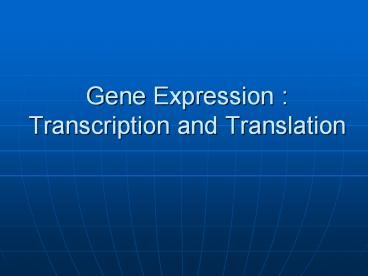Gene Expression : Transcription and Translation PowerPoint PPT Presentation
Title: Gene Expression : Transcription and Translation
1
Gene Expression Transcription and Translation
2
How Are Different Types of Cells Created and
Maintained?
By differential gene expression.
The same genetic information is in all 100
trillion cells of any one person. Different cells
use the same blueprint in different ways.
How?
In essence, the control of gene expression occurs
by regulating the flow of information from DNA to
protein.
3
The Central Dogma of Molecular Genetics
DNA
Trait
RNA
Protein
4
Review
- DNA
- RNA
- Proteins
Made up of 4 different nucleotides
Made up of 4 different nucleotides
Made up of 20 different amino acids
5
Gene Expression in Prokaryotes vs. Eukaryotes
- Transcription and translation are separated in
time and space
- Transcription and translation may occur
simultaneously
6
The Genetic Code
- Problem How do only 4 different nucleotides code
for the 20 amino acids that make up proteins?
- Solution Each group of 3 nucleotides codes for a
different amino acid. These 3 nuclotide units are
called codons.
DNA
RNA
Amino Acid
C
G
Valine
A
U
T
A
7
Reading Frame
- The 3-nucleotide units (codons) must be read in
the correct reading frame
- Start codons determine the reading frame
8
The Genetic Code Dictionary
- There are multiple codons for each amino acid
- AUG is always the start codon
- UAA, UGA, and UAG are stop codons
9
Transcription
- DNA is used to make a strand of RNA called the
primary transcript (pre-mRNA)
- The pre-mRNA is further processed to create the
finished mRNA
- mRNA exits the nucleus to be translated
10
Transcription
- 3 main steps
1. Initiation
2. Elongation
3. Termination
11
Transcription Initiation
- RNA polymerase binds to DNA at a region called
the promoter
- RNA polymerase unwinds the DNA and adds
nucleotides in the 5 ? 3 direction
12
Transcription Elongation
- RNA polymerase moves along the DNA strand, adding
60 nucleotides/sec
- DNA strands rejoin after polymerase passes by
13
Transcription Termination
- Polymerase stops when it reaches a DNA sequence
called the terminator
- The mRNA has been completely transcribed
- In eukaryotes, this is pre-mRNA and must be
further processed
14
mRNA Processing
- In eukaryotes, pre-mRNA must be further processed
to mRNA before it leaves the nucleus
- Guanine is added to 5 end, forming the 5 cap
- 100s of adenines are added to 3 end, forming
the poly-A tail
- Non-coding regions of RNA are spliced out
15
- Intron (non-coding sequences) are cut out by
spliceosomes. Leaving only Exons (Coding
sequences) making up the mRNA that leaves the
nucleus. - Alternative splicing patterns means one gene can
make more than one protein
16
mRNA Splicing
17
Translation
- The process in which mRNA is used to make proteins
- Occurs in the cytoplasm using ribosomes
- Requires tRNA bound to amino acid
- 3 steps initiation, elongation, termination
18
tRNA
- A clover-shaped RNA molecule
19
Structure of tRNA
- 3 end of tRNA binds to specific amino acids
- Anti-codon on tRNA complements mRNA codon
20
tRNA Synthesis
- RNA is made in the nucleus
- Amino acids float free in the cytoplasm
- Aminoacyl-tRNA synthase joins each amino acid to
the appropriate tRNA
21
Ribosomes
- 2 subunits
- Composed of proteins and rRNA
- 3 tRNA binding sites
22
Translation Initiation
- mRNA, tRNA and small ribosomal subunit bind with
the P site at the start codon
- Large subunit binds using energy from GTP
23
Translation Elongation
- mRNA is read 3 nucleotides at a time (Codons)
- tRNA brings corresponding amino acid into the A
site of the ribosome
24
- Ribosome catalyses dehydration synthesis reaction
between amino acids in P site and A site - Growing polypetpide now attached to tRNA in A
site - Ribosome moves forward one codon
- Free tRNA in P site exits out the back of
ribosome - tRNA (with polypeptide) moves into P site
25
Translation Termination
- Elongation continues until reaching a stop codon
- Release factor binds and hydrolyzes the bond
between the last tRNA and its a.a., freeing the
new protein
26
Polyribosomes
- Many ribosomes may simultaneously translate from
a single mRNA
27
Gene Expression Overview

